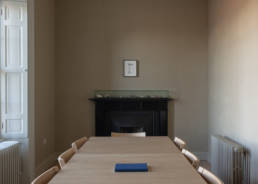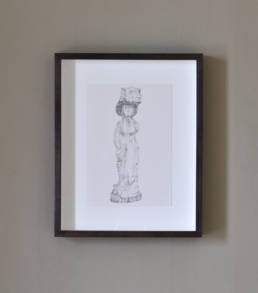Rumours of a New Planet
Collective, Edinburgh
24 Nov 2018 → 31 Mar 2019
Rumours of a New Planet was produced during Collective’s relocation to the City Observatory on Calton Hill, Edinburgh, and was part of their inaugural programme, Affinity and Allusion. It was structured around people and narratives that are generally not included in the dominant histories of what is a rich and storied site. Calton Hill is a destination that one looks from as much as one looks at, whether one is looking up at the stars through a telescope, down into the ground via the deep-earth thermometer that was also present in the observatory, or out across the city to produce a panorama. I like to think of this mode of orientation as an astronomical approach to site-specificity, a form of constellational activity that draws attention to a site through the phenomena visible from it. Rumours of a New Planet consisted of three intertwining project elements that was based on people who lived or worked on or around Calton Hill during its scientific heyday. Each of the projects were initiated separately but developed alongside each other, such that each element reflected, contained and revealed aspects of the other two elements.
The exhibition contained the following works:
The Manenberg Tornado (2018)
26 drawings (coloured pencil on paper)
The Manenberg Tornado is based on a set of botanical paintings made by Margaret Stewart (1810–1884) while she was in South Africa from 1834 to 1838. As a teenager, Stewart lived at the foot of Calton Hill, as her father was Minister for the Canongate. When her father died, the family moved to London, where Stewart met and married the astronomer, John Herschel. They immediately moved to Claremont, a suburb of Cape Town, where Herschel wanted to build a telescope. The couple undertook a number of excursions throughout the colonised surrounds, collecting botanical samples from which Stewart produced a portfolio of 132 images that formed a concentrated representation of the Cape’s native species. Stewart also wrote diaries and posted letters back to Britain in which she addressed the politics of the colony, often challenging the reporting of confrontations between settler and indigenous populations that appeared in the British press.
In 2017, I re-enacted one of Stewart’s excursions, a 100km round trip that stretched from Claremont in the west to Gordon’s Bay in the east. In the 1830s, this route was sparsely populated and was traversed by rough tracks, but today it is a densely populated region consisting of wealthy suburbs, formal and informal townships, small industry, urban farms, conservation areas and tourist sites. I met a number of people who live and work on the route – including residents, conservationists, activists, academics, amateur botanists, and farmers – and talked to them about their relationship with the land.
In The Manenberg Tornado, each encounter is represented by a drawing of whatever was growing on the site it occurred, whether that be a rare native species, a weed, a vegetable, or a pot plant from a garden centre. The work was a means to help me understand the spaces and politics of post-apartheid Cape Town through an engagement with how land is organised, occupied and articulated.
In Rumours of a New Planet, the drawings were shown in rotation in the glass cabinet of the observatory library.
One Drop of Water Contains as Much Electricity as Would Make a Thunderstorm (2018)
8 drawings, 14 rock samples, 1 book containing 11 essays
This work is based on the travel journals of Jessica Duncan (1812–1896) who, in 1847, moved from rural Aberdeenshire to Edinburgh to study geology under Alexander Rose (who’d founded the Edinburgh Geology Society four years earlier). Over the ensuing seven years, Duncan kept notebooks containing transcriptions of Rose’s forty-three lectures, diagrams of strata and fossils, translations of essays by European geologists, fieldwork schematics, and notes on local and national excursions. In 1855 she married the last Astronomer Royal for Scotland to be based at Calton Hill, Charles Piazzi Smyth (1819–1900), and became his de facto assistant, placing her scientific knowledge in his service rather than her own.
The final entry in her geology notebooks documents her final solo scinetific endeavour before meeting Smyth: an ambitious excursion from Dieppe to Florence that she undertook over several weeks in 1854. She travelled by train and boat, stopping off at key geological sites throughout France, Switzerland and Italy in order to carry out field trips by foot. Many of these sites remain remote and arduos today, so would likely have been especially taxing in the mid-nineteenth century. In 2016 I undertook the same excursion over ten days, moving between the sites by camper van. Instead of thinking about the sites geologically, I focussed on incidents from art and cultural history that had occurred in the interim 164 years. Much like Duncan’s experience is represented by her travel journal, I produced a book of essays based on the places that appear along her route. Taken as a set, my essays draw parallels between undertaking an excursion and visiting an exhibition, and connect ways of looking/thinking geologically with ways of looking/thinking curatorially.
One Drop of Water… consists of the book, a set of rock samples collected en-route, and a drawing of Michelangelo Pistoletto’s sculpture Dietro-Front (1981-84), which is located at the city-gates of Florence, the furthest-most point on the excursion. I drew Pistoletto’s sculpture from eight different angles, and when One Drop of Water… is exhibited the drawings are shown one at a time, such that image appears to rotate like a clock slowly counting-down to the end of the exhibition.
The Sightseers (2018)
Sound (36 minutes and 22 seconds)
This work is based on two small asides mentioned in the biographies of the first Astronomer Royal for Scotland, Thomas Henderson (1798–1844) and Thomas Anderson (1853–1932), an amateur astronomer who discovered an undocumented temporary star when looking at the sky from his bedroom window in 1892. Both men had problems with their eyes, Anderson having given up his job as a minister as he couldn’t see well enough to read his sermons, and Henderson suffering from bouts of near blindness. Furthermore, another amateur astronomer in Edinburgh, James Gall, founded a printing-press specialising in astronomy and in books for the blind, written in a pre-Braille raised typeface designed by his father.
On the back of these stories, Collective and I approached the RNIB (Royal National Institute for Blind People), which has a community centre at the foot of Calton Hill, and developed a project with help from The Lothian Blind Ramblers, a walking group for visually-impaired people. The Lothian Blind Ramblers go on excursions around the Scottish countryside, moving around in pairs made up of a visually-impaired person and their sighted guide. The conversations within the pairs are highly layered, consisting of – for instance – information that is immediately relevant (such as practical descriptions of the terrain or warnings of hazards), information that is tangentially relevant (such as aesthetic observations about the landscape and its contents), and information drawn from outwith the immediate situation (such as stories and anecdotes, or discussions of politics, memories, hobbies and so on). These essentially function as a foreground, a middle ground and a background, and those who go on such walks regularly are extremely adept at moving seamlessly between the layers as if each one is a different sense operating simultaneously with the others.
For The Sightseers, I recorded the conversations of four pairs of ramblers as they undertook walks around Calton Hill, and a subsequent conversation between the whole group back at the gallery. These conversations were then broken down into small parts and partially reconstructed as a play to be performed by two actors – one playing a visually-impaired rambler and the other a guide. The play utilised the many layers of spoken communication to generate an audio-guide for Calton Hill as part of Collective’s Observer’s Walks programme. The play can be listened to here, or on an iPod borrowed at Collective’s reception desk.
The walkers were Victor Aitken, Gail Donald, Elizabeth Douglas, Paddy Dresser, John Howie, Jimmy Milhench, Chris Morris and Dennis Wilson. The sound was recorded by Jack Coghill and Dougie Fairgrieve, and the actors who performed the play were Eliza Langland and Simon Tait.
Part of:
Affinity and Allusion
Collective, Edinburgh (24 Nov 2018 → 31 Mar 2019)







